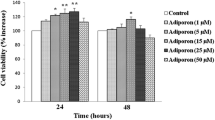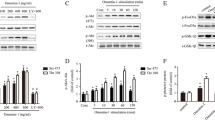Abstract
Adipose-derived mesenchymal stem cells (Ad-MSCs) have been designated as the promising agents for clinical applications for easy accessibility, multi-linage differentiation and immunomodulation capacity. Despite this, optimal cell delivery conditions have remained as a clinical challenge and improvement of stem cell homing to the target organs is being considered as a major strategy in cell therapy systemic injection. It has been shown that homing of mesenchymal stem cells are increased when treated with physical or chemical hypoxia-mimicking factors, however, efficiency of different agents remained to be determined. In this study, hypoxia-mimicking agents, including valproic acid (VPA), cobalt chloride (CoCl2) and deferoxamine (DFX) were examined to determine whether they are able to activate signaling molecules involved in migration of Ad-MSCs in vitro. We report that Ad-MSCs treated by DFX resulted in a significantly enhanced mRNA expression of MAPK4 (associated with MAPK signaling pathway), INPP4B (associated with Inositol polyphosphate pathway), VEGF-A and VEGF-C (associated with cytokine–cytokine receptor pathways), IL-8 and its receptor, CXCR2 (associated with IL-8 signaling pathway). While the cells treated with VPA did not show such effects and CoCl2 only upregulated VEGF-A and VEGF-C gene expression. Furthermore, results of wound-healing assays showed migration capacity of Ad-MSCs treated with DFX significantly increased 8 and 24 h of the treatment. This study provides credible evidence around DFX, which might be an effective drug for pharmacological preconditioning of Ad-MSCs to boost their homing capacity and regeneration of damaged tissues though, activation of the migration-related signaling pathways.




Similar content being viewed by others
References
Al-Sowayan B, Keogh RJ, Abumaree M, Georgiou HM, Kalionis B (2019) Valproic acid stimulates in vitro migration of the placenta-derived mesenchymal stem/stromal cell line CMSC29. Stem Cell Investig 6:3
Bancroft CC, Chen Z, Dong G, Sunwoo JB, Yeh N, Park C, Van Waes C (2001) Coexpression of proangiogenic factors IL-8 and VEGF by human head and neck squamous cell carcinoma involves coactivation by MEK-MAPK and IKK-NF-κB signal pathways. Clin Cancer Res 7:435–442
Campbell M, Trimble ER (2005) Modification of PI3K-and MAPK-dependent chemotaxis in aortic vascular smooth muscle cells by protein kinase CβII. Circ Res 96:197–206
Chen Y, Tsai Y-H, Tseng S-H (2012) Valproic acid affected the survival and invasiveness of human glioma cells through diverse mechanisms. J Neurooncol 109:23–33
Chen L, Cui X, Wu Z, Jia L, Yu Y, Zhou Q et al (2014) Transplantation of bone marrow mesenchymal stem cells pretreated with valproic acid in rats with an acute spinal cord injury. Biosci Trends 8:111–119
Deezagi A, Shomali S (2018) Prostaglandin F-2α stimulates the secretion of vascular endothelial growth factor and induces cell proliferation and migration of adipose tissue derived mesenchymal stem cells. Cell J 20:259–266
Fu X, Liu G, Halim A, Ju Y, Luo Q, Song G (2019) Mesenchymal stem cell migration and tissue repair. Cells 8:784
Gasser JA, Inuzuka H, Lau AW, Wei W, Beroukhim R, Toker A (2014) SGK3 mediates INPP4B-dependent PI3K signaling in breast cancer. Mol Cell 56:595–607
Gimble JM, Katz AJ, Bunnell BA (2007) Adipose-derived stem cells for regenerative medicine. Circ Res 100:1249–1260
Guo M, Song L-P, Jiang Y, Liu W, Yu Y, Chen G-Q (2006) Hypoxia-mimetic agents desferrioxamine and cobalt chloride induce leukemic cell apoptosis through different hypoxia-inducible factor-1α independent mechanisms. Apoptosis 11:67–77
Hashemzadeh MR, Seyedi Z, Rafiei S, Hassanzadeh-Moghaddam M, Edalatmanesh MA (2017) Chemokine receptor’s expression in human adipose derived mesenchymal stem cells primed with valproic acid. Comp Clin Path 26:115–120
Heirani-Tabasi A, Toosi S, Mirahmadi M, Mishan MA, Bidkhori HR, Bahrami AR et al (2017) Chemokine receptors expression in MSCs: comparative analysis in different sources and passages. Tissue Eng Regen Med 14:605–615
Heirani-Tabasi A, Naderi-Meshkin H, Matin MM, Mirahmadi M, Shahriyari M, Ahmadiankia N et al (2018) Augmented migration of mesenchymal stem cells correlates with the subsidiary CXCR4 variant. Cell Adh Migr 12:118–126
Hu C, Zhao L, Li L (2019) Current understanding of adipose-derived mesenchymal stem cell-based therapies in liver diseases. Stem Cell Res Ther 10:199
Hung S-C, Pochampally RR, Hsu S-C, Sanchez C, Chen S-C, Spees J, Prockop DJ (2007) Short-term exposure of multipotent stromal cells to low oxygen increases their expression of CX3CR1 and CXCR4 and their engraftment in vivo. PloS ONE 2:e416
Jeong H-J, Chung H-S, Lee B-R, Kim S-J, Yoo S-J, Hong S-H, Kim H-M (2003) Expression of proinflammatory cytokines via HIF-1α and NF-κB activation on desferrioxamine-stimulated HMC-1 cells. Biochem Biophys Res Commun 306:805–811
Kuhbier JW, Weyand B, Radtke C, Vogt PM, Kasper C, Reimers K (2010) Isolation, characterization, differentiation, and application of adipose-derived stem cells. Adv Biochem Eng Biotechnol 123:55–105
Lee H-J, Lee J, Lee S-K, Lee S-K, Kim E-C (2007) Differential regulation of iron chelator-induced IL-8 synthesis via MAP kinase and NF-κB in immortalized and malignant oral keratinocytes. BMC Cancer 7:176
Li A, Dubey S, Varney ML, Dave BJ, Singh RK (2003) IL-8 directly enhanced endothelial cell survival, proliferation, and matrix metalloproteinases production and regulated angiogenesis. J Immunol 170:3369–3376
Liu H, Xue W, Ge G, Luo X, Li Y, Xiang H et al (2010) Hypoxic preconditioning advances CXCR4 and CXCR7 expression by activating HIF-1α in MSCs. Biochem Biophys Res Commun 401:509–515
Liu GS, Peshavariya HM, Higuchi M, Chan EC, Dusting GJ, Jiang F (2016) Pharmacological priming of adipose-derived stem cells for paracrine VEGF production with deferoxamine. J Tissue Eng Regen Med 10:E167–E176
Liu L, Chen J-X, Zhang X-W, Sun Q, Yang L, Liu A et al (2018) Chemokine receptor 7 overexpression promotes mesenchymal stem cell migration and proliferation via secreting Chemokine ligand 12. Sci Rep 8:204
Locke M, Windsor J, Dunbar PR (2009) Human adipose-derived stem cells: isolation, characterization and applications in surgery. ANZ J Surg 79:235–244
Masoud Y, Ramin S, Mahboobeh R, Mehrnoosh M, Fahimeh J, Parastoo K (2019) Effect of lithium and valproate on proliferation and migration of limbal epithelial stem/progenitor cells. Curr Eye Res 44:154–161
Mirahmadi M, Rezanejadbardaji H, Irfan-Maqsood M, Mokhtari MJ, Naderi-Meshkin H (2016a) Stem cell therapy for neurodegenerative diseases: strategies for regeneration against degeneration. Cell Ther Regen Med J 1:3
Mirahmadi M, Ahmadiankia N, Naderi-Meshkin H, Heirani-Tabasi A, Bidkhori HR, Afsharian P, Bahrami AR (2016b) Hypoxia and laser enhance expression of SDF-1 in muscles cells. Cell Mol Biol 62:31–37
Mishan MA, Heirani-Tabasi A, Mokhberian N, Hassanzade M, Moghaddam HK, Bahrami AR, Ahmadiankia N (2015) Analysis of chemokine receptor gene expression in esophageal cancer cells compared with breast cancer with insights into metastasis. Iran J Public Health 44:1353–1358
Mishan MA, Ahmadiankia N, Bahrami AR (2016) CXCR4 and CCR7: Two eligible targets in targeted cancer therapy. Cell Biol Int 40:955–967
Naderi-Meshkin H, Bahrami AR, Bidkhori HR, Mirahmadi M, Ahmadiankia N (2015) Strategies to improve homing of mesenchymal stem cells for greater efficacy in stem cell therapy. Cell Biol Int 39:23–34
Naderi-Meshkin H, Matin MM, Heirani‐Tabasi A, Mirahmadi M, Irfan‐Maqsood M, Edalatmanesh MA et al (2016) Injectable hydrogel delivery plus preconditioning of mesenchymal stem cells: exploitation of SDF‐1/CXCR4 axis toward enhancing the efficacy of stem cells’ homing. Cell Biol Int 40:730–741
Onda K, Yoshida H, Hayakari R, Xing F, Wang L, Matsumiya T et al (2016) Desferrioxamine, an iron chelator, induces CXCL8 expression in U373MG human astrocytoma cells. Hirosaki Med J 66:127–134
Oses C, Olivares B, Ezquer M, Acosta C, Bosch P, Donoso M et al (2017) Preconditioning of adipose tissue-derived mesenchymal stem cells with deferoxamine increases the production of pro-angiogenic, neuroprotective and anti-inflammatory factors: potential application in the treatment of diabetic neuropathy. PLoS One 12:e0178011
Peyvandi A, Abbaszadeh HA, Roozbahany NA, Pourbakht A, Khoshsirat S, Niri HH, Peyvandi H, Niknazar S (2018) Deferoxamine promotes mesenchymal stem cell homing in noise-induced injured cochlea through PI 3K/AKT pathway. Cell Prolif 51:e12434
Sharma M, Afrin F, Tripathi R, Gangenahalli G (2013) Regulated expression of CXCR4 constitutive active mutants revealed the up-modulated chemotaxis and up-regulation of genes crucial for CXCR4 mediated homing and engraftment of hematopoietic stem/progenitor cells. J Stem Cells Regen Med 9:19–27
Sinn D-I, Kim S-J, Chu K, Jung K-H, Lee S-T, Song E-C et al (2007) Valproic acid-mediated neuroprotection in intracerebral hemorrhage via histone deacetylase inhibition and transcriptional activation. Neurobiol Dis 26:464–472
Smith AN, Willis E, Chan VT, Muffley LA, Isik FF, Gibran NS, Hocking AM (2010) Mesenchymal stem cells induce dermal fibroblast responses to injury. Exp Cell Res 316:48–54
Spaeth E, Klopp A, Dembinski J, Andreeff M, Marini F (2008) Inflammation and tumor microenvironments: defining the migratory itinerary of mesenchymal stem cells. Gene Ther 15:730–738
Tang H, Sun Y, Shi Z, Huang H, Fang Z, Chen J et al (2013) YKL-40 induces IL-8 expression from bronchial epithelium via MAPK (JNK and ERK) and NF-κB pathways, causing bronchial smooth muscle proliferation and migration. J Immunol 190:438–446
Timoshenko A, Rastogi S, Lala P (2007) Migration-promoting role of VEGF-C and VEGF-C binding receptors in human breast cancer cells. Br J Cancer 97:1090–1098
Toosi S, Naderi-Meshkin H, Kalalinia F, Pievandi MT, Hosseinkhani H, Bahrami AR et al (2017) Long bone mesenchymal stem cells (Lb-MSCs): clinically reliable cells for osteo-diseases. Cell Tissue Bank 18:489–500
Tsai L-K, Leng Y, Wang Z, Leeds P, Chuang D-M (2010) The mood stabilizers valproic acid and lithium enhance mesenchymal stem cell migration via distinct mechanisms. Neuropsychopharmacology 35:2225–2237
Vindis C, Cerretti DP, Daniel TO, Huynh-Do U (2003) EphB1 recruits c-Src and p52Shc to activate MAPK/ERK and promote chemotaxis. J Cell Biol 162:661–671
Wahl EA, Schenck TL, Machens H-G, Balmayor ER (2016) VEGF released by deferoxamine preconditioned mesenchymal stem cells seeded on collagen-GAG substrates enhances neovascularization. Sci Rep 6:36879
Wang J, Tsirka SE (2005) Neuroprotection by inhibition of matrix metalloproteinases in a mouse model of intracerebral haemorrhage. Brain 128:1622–1633
Wang J, Wang Y, Wang S, Cai J, Shi J, Sui X et al (2015) Bone marrow-derived mesenchymal stem cell-secreted IL-8 promotes the angiogenesis and growth of colorectal cancer. Oncotarget 6:42825–42837
Waugh DJ, Wilson C (2008) The interleukin-8 pathway in cancer. Clin Cancer Res 14:6735–6741
Woo KJ, Lee T-J, Park J-W, Kwon TK (2006) Desferrioxamine, an iron chelator, enhances HIF-1α accumulation via cyclooxygenase-2 signaling pathway. Biochem Biophys Res Commun 343:8–14
Yagi H, Soto-Gutierrez A, Parekkadan B, Kitagawa Y, Tompkins RG, Kobayashi N, Yarmush ML (2010) Mesenchymal stem cells: mechanisms of immunomodulation and homing. Cell Transpl 19:667–679
Yamanegi K, Yamane J, Kobayashi K, Kato-Kogoe N, Ohyama H, Nakasho K et al (2012) Valproic acid cooperates with hydralazine to augment the susceptibility of human osteosarcoma cells to Fas-and NK cell-mediated cell death. Int J Oncol 41:83–91
Yoo HI, Moon YH, Kim MS (2016) Effects of CoCl2 on multi-lineage differentiation of C3H/10T1/2 mesenchymal stem cells. Korean J Physiol Pharmacol 20:53–62
Zgouras D, Becker U, Loitsch S, Stein J (2004) Modulation of angiogenesis-related protein synthesis by valproic acid. Biochem Biophys Res Commun 316:693–697
Author information
Authors and Affiliations
Corresponding author
Ethics declarations
Conflict of interest
All the authors declare that they have no competing interests.
Ethical approval
The institutional review board of Iranian Academic Center for Education, Culture and Research (ACECR) approved the study protocol (IRB No. IR.ACECR.JDM.REC.1396.7). Informed consent was confirmed by the IRB. There are no animal experiments carried out for this article.
Additional information
Publisher's Note
Springer Nature remains neutral with regard to jurisdictional claims in published maps and institutional affiliations.
Rights and permissions
About this article
Cite this article
Heirani-Tabasi, A., Mirahmadi, M., Mishan, M.A. et al. Comparison the effects of hypoxia-mimicking agents on migration-related signaling pathways in mesenchymal stem cells. Cell Tissue Bank 21, 643–653 (2020). https://doi.org/10.1007/s10561-020-09851-2
Received:
Accepted:
Published:
Issue Date:
DOI: https://doi.org/10.1007/s10561-020-09851-2




